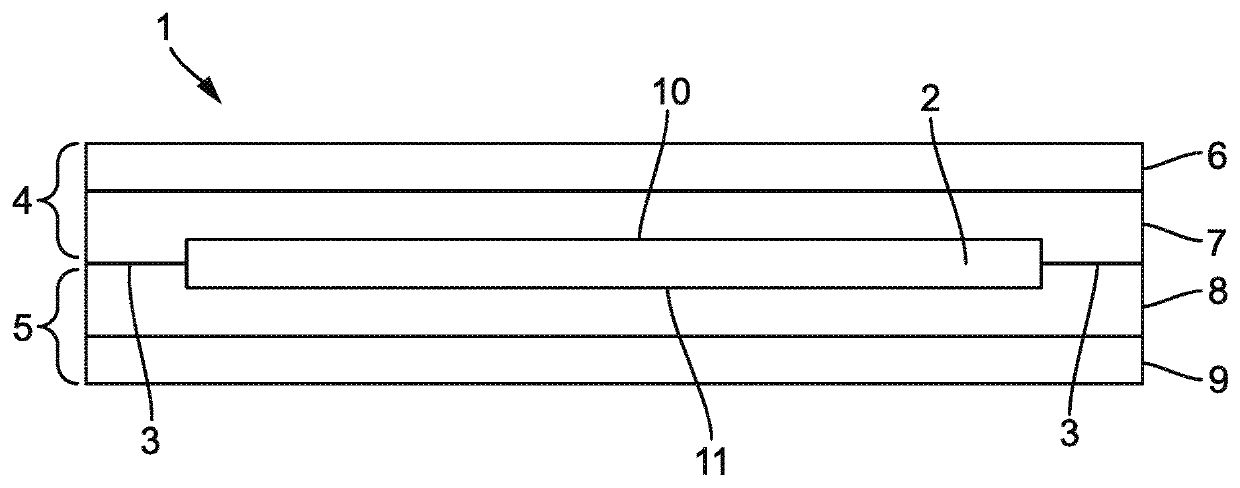Film laminates based on polyaryletherketones
a technology of polyaryl etherketone and film laminate, which is applied in the field of polyaryl etherketone, can solve the problems of limiting the effectiveness of polyimide as an insulating material, the type of polymeric laminate has certain deficiencies, and the polyimide is relatively hygroscopic, so as to achieve high degree of compatibility, high degree of heat resistance, and high degree of delamination resistance
- Summary
- Abstract
- Description
- Claims
- Application Information
AI Technical Summary
Benefits of technology
Problems solved by technology
Method used
Image
Examples
example 1
[0108]A first film layer consisting of an amorphous film of Kepstan® 6002 PEKK (Arkema) with a thickness of 50 microns, a melting point of 295° C. and a glass transition temperature of 160° C. was placed onto a second film layer consisting of an amorphous film of Kepstan® 8002 PEKK (Arkema) with a thickness of 50 microns, a melting point of 355° C. and a glass transition temperature of 163° C. The resulting assembly was placed into a hot roll laminator with a moveable heated steel roll and a rubberized drive wheel. The top roll was heated to 220° C., and the feed rate was fixed at 50 cm / min. Pneumatic cylinders were used to clamp the top roll to the bottom with modest force. The laminate obtained had a thickness of 100 microns, and a good cohesive bonding between the two layers was obtained. The laminate exhibited an amorphous state on the first film layer side, and the second film layer was also amorphous. The film laminate obtained can be further heated under conditions such that ...
example 2 (
Prophetic)
[0109]A first film layer consisting of an amorphous film of Kepstan® 6002 PEKK (Arkema) with a thickness of 50 microns, a melting point of 295° C. and a glass transition temperature of 160° C. is placed onto a second film layer consisting of a semi-crystalline film of Kepstan® 8002 PEKK (Arkema) with a thickness of 50 microns, a melting point of 355° C. and a glass transition temperature of 163° C. The resulting film assembly is laminated under conditions identical to those described in Example 1. The film laminate obtained is expected to have a thickness of 100 microns and to exhibit a good cohesive bonding between the two film layers. The film laminate is expected to exhibit an amorphous state on the first film layer side, and the second film layer is expected to be semi-crystalline.
example 3 (
Prophetic)
[0110]A first film layer consisting of an amorphous film of Kepstan® 6002 PEKK (Arkema) with a thickness of 30 microns and a melting point of 295° C. and glass transition temperature of 160° C. is placed onto a second film layer consisting of a semi-crystalline film of Kepstan™ 8002 PEKK (Arkema) with a thickness of 150 microns, a melting point of 355° C. and a glass transition temperature of 163° C. The film assembly is laminated under conditions identical to those described in Example 1. The film laminate obtained is expected to have a thickness of 180 microns, and to exhibit a good cohesive bonding between the two film layers. The film laminate is expected to exhibit an amorphous state on the first film layer side, and the second film layer is expected to be semi-crystalline.
PUM
| Property | Measurement | Unit |
|---|---|---|
| melting point | aaaaa | aaaaa |
| melting point | aaaaa | aaaaa |
| melting point | aaaaa | aaaaa |
Abstract
Description
Claims
Application Information
 Login to View More
Login to View More - R&D
- Intellectual Property
- Life Sciences
- Materials
- Tech Scout
- Unparalleled Data Quality
- Higher Quality Content
- 60% Fewer Hallucinations
Browse by: Latest US Patents, China's latest patents, Technical Efficacy Thesaurus, Application Domain, Technology Topic, Popular Technical Reports.
© 2025 PatSnap. All rights reserved.Legal|Privacy policy|Modern Slavery Act Transparency Statement|Sitemap|About US| Contact US: help@patsnap.com

